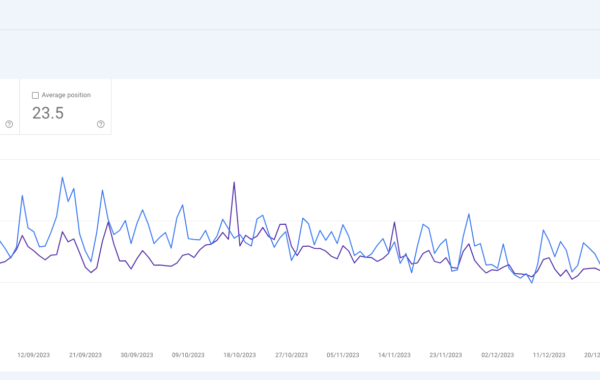Your website serves as a key focus for your online growth.
Whether you like it or not, a poorly thought-out website can make or break a potential conversion.
It’s not just a platform to showcase your business, your services or your products. It’s a key marketing tool for generating leads, nurturing potential clients and ultimately securing online sales.
But how can you use it to your advantage, stay competitive and above all else – complement your business growth?
Your website’s role in lead generation
Your website’s first impression can significantly influence a visitor’s decision to engage further with your brand. When we think about B2B lead generation, your digital presence functions as a virtual brochure, setting the tone for future interactions and engagements between businesses. A well-designed website that speaks clearly to your target audience can significantly increase your lead-generation efforts, turning casual visitors into valuable leads or clients.
Your website serves as a central hub of information about your products, services, and company. It should provide detailed and organised content that educates visitors about what you offer and how it can benefit them.
Blog posts, articles, videos, and other types of content on your website can address common questions and pain points of your target audience. This content not only helps educate visitors but also establishes your authority and credibility, making them more likely to become leads.
Key reasons your website isn’t converting
Several factors can deter your website from converting visitors into leads or sales effectively. A lack of a clear value proposition, poor usability, slow loading times, ineffective calls-to-action (CTAs), and insufficient content tailored to your audience’s needs are common culprits. Addressing these issues is paramount to improving your site’s conversion rates.
Here are some reasons why you might expect to be missing out on conversion opportunities:
High bounce rate
If visitors are leaving your site quickly (high bounce rate), it may indicate that your content or design isn’t engaging enough.
Technical issues
Broken links, forms that don’t work, or other technical glitches can frustrate visitors and prevent conversions.
Lack of social proof
Genuine reviews, case studies, and success stories can build trust and encourage conversions.
Lack of clear call-to-action(s)
If your website lacks prominent and persuasive CTAs, visitors may not know what action to take next.
Poor user experience
Slow loading times: Visitors may leave if your site takes too long to load.
Complex navigation: A confusing or cluttered layout can make it difficult for users to find what they’re looking for.
Mobile responsiveness issues: If your site is not optimised for mobile devices, you could lose potential leads from mobile users.
Unclear value proposition
Visitors need to quickly understand the unique value your products or services offer. If it’s unclear, they may leave without converting.
Conversion rate optimisation
Conversion Rate Optimisation (CRO) is a systematic approach to increasing the percentage of visitors who take a desired action on your website. Whether it’s filling out a form, making a purchase, or subscribing to a newsletter, CRO focuses on understanding how users move through your site, what actions they take, and what’s stopping them from completing your goals.
A key service we provide for our clients looks at a 360 approach to understanding exactly what’s causing a bottleneck in conversions and how we can look at testing, improving and analysing updates to generate more leads, increase online sales and whole fully improve the user experience.
Optimising your website for better lead generation
Improving your website’s design, user experience (UX), and content are crucial steps toward better lead generation. Specifically, optimising your WordPress and Shopify landing pages can lead to higher engagement and conversion rates. Implementing best practices in landing page design, such as clear headings, engaging visuals, and persuasive copy, can significantly impact your lead generation efforts.
Leveraging lead generation services and agencies
For businesses looking to enhance their lead generation strategies, partnering with a lead generation company or agency can offer valuable expertise and resources. These services provide targeted strategies and tools designed to attract and capture more qualified leads for your business, enhancing your overall marketing efforts.
SEO and your website’s potential
Search Engine Optimization (SEO) can significantly improve a website’s potential by increasing its visibility in search engine results pages (SERPs) and driving targeted organic traffic. Here’s how SEO can benefit your website:
Increased organic traffic: SEO techniques help improve your website’s ranking in search engines like Google. As your site climbs higher in the search results, it becomes more accessible to users searching for relevant keywords, leading to an increase in organic traffic.
Targeted audience: SEO allows you to optimize your website for specific keywords and phrases related to your products or services. This helps attract visitors who are actively searching for what you offer, increasing the likelihood of converting them into customers or leads.
Credibility and trust: Websites that appear on the first page of search results are often perceived as more trustworthy and credible by users. SEO can enhance your website’s reputation and authority in your industry.
Better user experience (UX): Part of SEO involves optimizing your website’s structure, content, and user interface. This leads to an improved user experience, making it easier for visitors to navigate your site, find information, and engage with your content.
Competitive advantage: SEO allows you to stay competitive in your industry. If your competitors are investing in SEO and you’re not, they are likely to capture a larger share of the online market.
Cost-effective marketing: Organic search traffic is free, making SEO one of the most cost-effective marketing strategies. While there are initial costs associated with SEO efforts, the long-term benefits often outweigh the investment.
Local visibility: For businesses targeting a local audience, local SEO strategies can help your website appear in local search results and Google Maps, making it easier for potential customers to find your physical location.
Long-term results: Properly executed SEO can yield long-lasting results. Once your website ranks well for specific keywords, it can continue to attract traffic and generate leads over an extended period without ongoing advertising costs.
Analytics and data insights: SEO tools provide valuable data and insights about your website’s performance, user behaviour, and keyword trends. This data can inform your marketing strategies and help you make data-driven decisions.
Mobile optimisation: With the increasing use of mobile devices for web browsing, SEO includes optimising for mobile-friendliness, ensuring your website is accessible to a broader audience.
Content quality: SEO encourages the creation of high-quality, informative, and engaging content that not only attracts visitors but also keeps them on your site longer and encourages sharing.
User engagement and conversion: SEO efforts can lead to improved user engagement, lower bounce rates, and increased conversion rates, as your site becomes more user-friendly and relevant to visitors.
Leverage analytics for your website optimisation
Utilising tools like Google Analytics or Google Search Console allows you to gain insights into your website’s performance, understand your audience’s behaviour, and identify areas for improvement. A/B testing, or split testing, is another critical strategy for optimising your website’s conversion rates, enabling you to compare different versions of your site to determine which performs better.
Mobile Optimisation
With the increasing prevalence of mobile browsing, ensuring your website is mobile-friendly is essential. Mobile optimisation affects not only user experience but also SEO rankings and, consequently, your site’s ability to generate leads and sales.
For e-commerce websites, the mobile checkout process must be streamlined and user-friendly. Offer multiple payment options, enable guest checkout, and provide progress indicators to keep users informed about their checkout progress.
Make your CTA buttons prominent and easily tapable on mobile devices. Use contrasting colours and concise, action-oriented text to encourage users to take specific actions like “Buy Now” or “Contact Us.”
Mobile screens are smaller, so it’s essential to simplify your website’s navigation. Use a clear and concise menu, hamburger menus (if necessary), and minimise the number of clicks required to reach essential pages or perform actions.
Build trust online
Incorporating social proof, such as customer testimonials and reviews, can significantly enhance your website’s credibility and persuasiveness. Displaying positive feedback from satisfied customers builds trust with prospective clients, encouraging them to engage with your business.
Ensure your website has a modern and professional design. A visually appealing site with a clean layout and high-quality images conveys credibility.
Display your contact information prominently on your website. Include a physical address, phone number, and email address. A physical location can add authenticity.
Display trust seals, security certifications, and industry affiliations prominently on your site. These symbols convey that your website follows best practices for security and data protection.
Showcase authentic testimonials, reviews, and success stories from satisfied customers. Social proof is a powerful trust-building element.
Effective call-to-action strategies
A compelling call to action is critical for guiding visitors toward taking the desired action on your website. Effective CTAs are clear, prominent, and aligned with the visitor’s stage in the buying journey, significantly impacting your conversion rates.
Explain the benefits of clicking the CTA button. Let visitors know what they’ll gain by taking the desired action, such as saving money, gaining knowledge, or improving their lives.
Provide incentives to motivate users to take action. This could include discounts, free trials, downloadable resources, or exclusive access.
Mention the number of satisfied customers, subscribers, or users if relevant to your CTA. Social proof can boost confidence in taking action.
Encourage immediate action by adding urgency to your CTA. Use terms like “Limited Time Offer,” “Act Now,” or “Last Chance” to convey a sense of scarcity.
The importance of continuous testing and improvement
The digital landscape is ever-evolving, and so should your website. Continuous testing and improvement are vital to staying ahead of the curve and ensuring your site remains effective in generating leads and driving sales.
Staying informed about the latest trends in website design and optimisation can help you leverage new technologies and methodologies to enhance your lead generation and conversion efforts.
FAQs
Q: What makes a website conversion optimised?
A: A conversion optimised website is designed with the user’s journey in mind. It includes clear and compelling calls-to-action (CTAs), a user-friendly layout, fast loading times, mobile responsiveness, high-quality content that addresses the user’s needs and questions, and effective use of social proof.
The goal is to remove barriers to conversion and make it as easy as possible for visitors to take the desired action, whether that’s making a purchase, signing up for a newsletter, or contacting your business.
Q: How can I improve my website’s loading speed?
A: Improving your website’s loading speed can be achieved by optimizing image sizes, utilizing content delivery networks (CDNs), minifying CSS, JavaScript, and HTML files, reducing redirects, leveraging browser caching, and choosing a reliable web hosting service. Tools such as Google’s PageSpeed Insights can provide specific recommendations to enhance the speed of your website.
Q: What are the best practices for designing effective CTAs?
A: Effective CTAs are visually striking, using colors that stand out from the rest of the page but still fit within the overall design scheme. They use action-oriented, persuasive language that creates a sense of urgency or benefit. Positioning is also crucial; CTAs should be placed where they’re most likely to catch the user’s attention, such as above the fold and near the content that convinces them to take action. Testing different versions can help identify the most effective design and copy.
Q: How does mobile optimization affect my website’s conversion rates?
A: Mobile optimisation is crucial for maintaining high conversion rates as a significant portion of web traffic comes from mobile devices. A mobile-optimized website provides a seamless experience to users across all devices, with fast loading times, responsive design that adjusts to different screen sizes, and easy navigation. This ensures that users can easily find and take the desired action, regardless of how they access your site, leading to higher engagement and conversion rates.
Q: Can SEO really improve my website’s lead generation?
A: Yes, SEO can significantly improve your website’s lead generation by increasing your site’s visibility in search engine results for relevant queries. This involves optimizing your site’s content with targeted keywords, improving site speed, ensuring mobile-friendliness, and building high-quality backlinks. By ranking higher in search engine results, you attract more organic traffic, which can lead to increased leads and conversions.
Q: What is the role of social proof in online sales?
A: Social proof, such as customer testimonials, reviews, case studies, and social media endorsements, plays a critical role in building trust and credibility with potential customers. It provides evidence of your product or service’s value from the perspective of others who have experienced it.
This can significantly influence buying decisions, as people are more likely to trust the word of other customers over a brand’s claims. Displaying social proof prominently on your website can help reassure visitors of the quality and reliability of your offerings, encouraging them to convert.
Your website ultimately plays a crucial role in determining the success of your sales and lead generation efforts. By understanding and addressing the key factors that influence your site’s conversion rates, and continuously optimizing your digital presence, you can significantly enhance your ability to generate leads and close sales. Implementing the strategies discussed in this article can help you create a website that not only attracts visitors but converts them into loyal customers.
If you want to accelerate your website’s success, you can do that with one of our website growth experts today! Just click here to apply to work with us, or you can book a discovery call with us here to get your FREE website audit with valuable, actionable insights to make your growth efforts smooth sailing.



